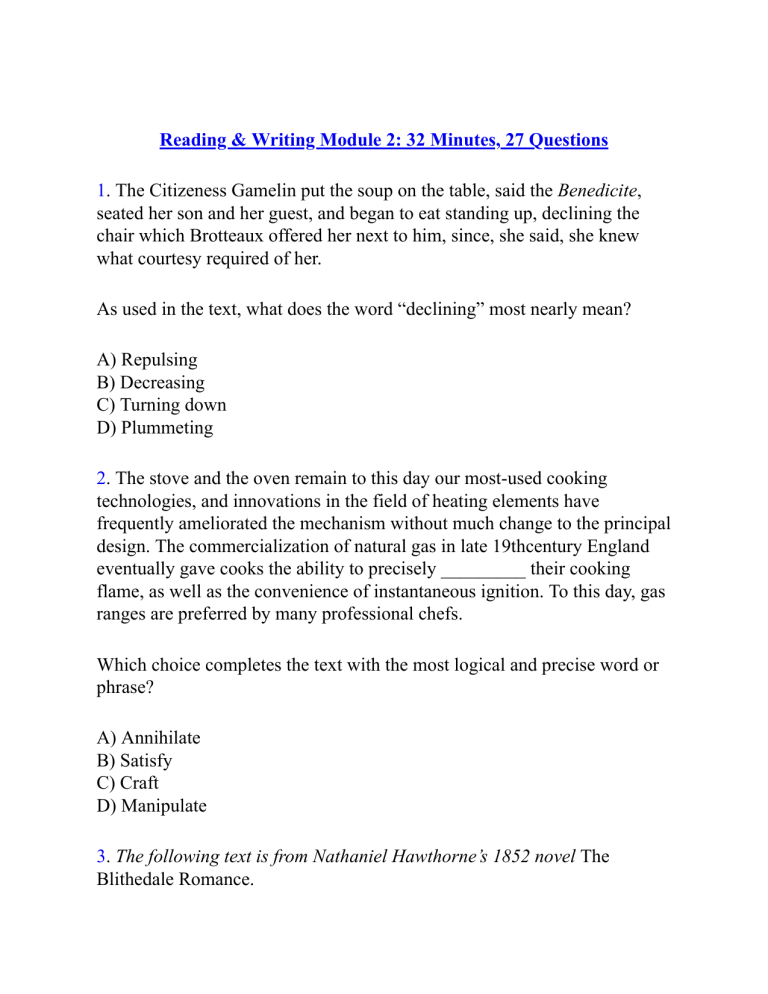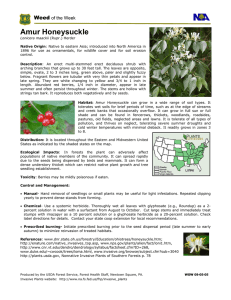
Reading & Writing Module 2: 32 Minutes, 27 Questions 1. The Citizeness Gamelin put the soup on the table, said the Benedicite, seated her son and her guest, and began to eat standing up, declining the chair which Brotteaux offered her next to him, since, she said, she knew what courtesy required of her. As used in the text, what does the word “declining” most nearly mean? A) Repulsing B) Decreasing C) Turning down D) Plummeting 2. The stove and the oven remain to this day our most-used cooking technologies, and innovations in the field of heating elements have frequently ameliorated the mechanism without much change to the principal design. The commercialization of natural gas in late 19thcentury England eventually gave cooks the ability to precisely _________ their cooking flame, as well as the convenience of instantaneous ignition. To this day, gas ranges are preferred by many professional chefs. Which choice completes the text with the most logical and precise word or phrase? A) Annihilate B) Satisfy C) Craft D) Manipulate 3. The following text is from Nathaniel Hawthorne’s 1852 novel The Blithedale Romance. 29 “Nothing,” answered I; “nothing, that I know of, unless to make pretty verses, and play a part, with Zenobia and the rest of the amateurs, in our pastoral. It seems but an unsubstantial sort of business, as viewed through a mist of fever. But, dear Hollingsworth, your own vocation is evidently to be a priest, and to spend your days and nights in helping your fellow-creatures to draw peaceful dying breaths.” As used in the text, what does the word “draw” most nearly mean? A) Inhale B) Provoke C) Infer D) Sketch 4. The following text is from Upton Sinclair’s 1906 novel The Jungle. The work which Jurgis was to do here was very simple, and it took him but a few minutes to learn it. He was provided with a stiff besom, such as is used by street sweepers, and it was his place to follow down the line the man who drew out the smoking entrails from the carcass of the steer; this mass was to be swept into a trap, which was then closed, so that no one might slip into it. Which choice best states the main purpose of the text? A) To analyze a character’s motivations B) To evaluate social conditions in the present-day United States C) To describe a character’s professional tasks D) To consider a likely objection by the reader 5. Spanning more than 1,500 miles, the border between Canada and the United States has been called the longest undefended international boundary in the world. This is true to some extent, in that neither the United States nor Canada maintains a military presence at the border. But as anyone who has crossed from one side of Niagara Falls to the other knows, 30 civilian law enforcement is present and accounted for at checkpoints on both sides of the boundary, where entrants are monitored and customs laws administered. Partly because of our cultural similarities and partly because of the remarkable amiability of our diplomatic relations over the past 150 years, it can sometimes seem almost as though the distinction between Canada and the United States is more of policy than of practice. Which choice best states the function of the underlined sentence in the text as a whole? A) To analyze the economic consequences of international borders on global commerce B) To explain the details of the security screenings that people who cross the U.S.-Canadian border must undergo C) To give evidence of the continual border hostility that the United States and Canada have had since the war of 1812 D) To clarify that although the United States and Canada have friendly relations, they are still clearly two different countries 6. Ernest Hemingway speaks of the artistry of another culture’s profanity with admiration in his celebrated novel, For Whom the Bell Tolls, wherein the narrator bears witness as obscenities and insults build to a high formalism and eventually collapse upon themselves, leaving the profanities implied rather than stated. The phenomenon described in the text is most like A) an aqueduct that is constructed in ancient times only to crumble as the centuries pass. B) the development of architectural technology enabling ever higher construction. C) the prohibition of subversive political meetings by an authoritarian dictator. 31 D) the evolution of painting from realistic portraiture to abstract expressionism. 7. Text 1 and Text 2 are adapted from different sections of the 1949 Geneva Conventions. Text 1 In addition to the provisions which shall be implemented in peacetime, the present Convention shall apply to all cases of declared war or of any other armed conflict which may arise between two or more of the High Contracting Parties, even if the state of war is not recognized by one of them. Text 2 Prisoners of war are in the hands of the enemy Power, but not of the individuals or military units who have captured them. Irrespective of the individual responsibilities that may exist, the Detaining Power is responsible for the treatment given them. The tones of both Text 1 and Text 2 can best be described as A) casual and relaxed. B) analytical and indecisive. C) formal and authoritative. D) melancholy and spontaneous. 8. Text 1 Melaleuca trees were brought to the Florida Everglades from Australia; developers thought these trees would help dry up vast swampy areas, enabling residential and commercial construction. Unfortunately, the trees 32 spread widely and covered up large swaths of the Everglades, displacing native plants. Florida has had to spend a great deal of money to remove these invasive trees. Text 2 Though common protocol would dictate that an invasive species like honeysuckle be removed from areas where it becomes dominant, these new findings demonstrate that such action would likely strike a significant blow to native bird populations. What’s more, areas that today are abundant in honeysuckle typically host 30 to 40 percent more birds than these same regions did thirty years ago, indicating a long-term change for the better. The author of Text 2 would most likely agree with which statement about Text 1? A) While invasive species may cause damage, not all invasive species should be considered harmful. B) Melaleuca trees demonstrate the importance of uniformly removing invasive species from the environment. C) Honeysuckle plants and melaleuca plants show the need for a consistent approach to invasive species management. D) So long as invasive plants are not transported across oceans, they are unlikely to be harmful. 9. The text is from Benjamin Franklin’s 1771 autobiography. Having emerged from the poverty and obscurity in which I was born and bred, to a state of affluence and some degree of reputation in the world, and having gone so far through life with a considerable share of felicity, the conducing means I made use of, which with the blessing of God so well succeeded, my posterity may like to know, as they may find some of them suitable to their own situations, and therefore fit to be imitated. 33 That felicity, when I reflected on it, has induced me sometimes to say, that were it offered to my choice, I should have no objection to a repetition of the same life from its beginning, only asking the advantages authors have in a second edition to correct some faults of the first. It is reasonable to conclude from the text that Franklin’s personal financial situation A) was as strong later in his life as it was when he was young. B) worsened as he advanced in years. C) had a random pattern of booms and busts over his life. D) improved greatly over his lifetime. 10. In the sense of Ferdinand Saussure’s theory of semiotics, one might suggest that the use of literal profanity—as opposed to figurative, which only possesses social sway based on its proximity to the literal—garners part of its power by being the closest available union of signifier and signified in subjects that, as a culture, we tend to avoid in polite and formal conversations. That is, the word is rude, because the thing itself—in a general context—is also considered rude. One can reasonably conclude that Ferdinand Saussure believes that a major factor that gives profanity its power is A) the real-life things it represents. B) its representation of conflict between symbolism and clarity. C) the rarity with which its ideas are encountered. D) its use by the socially dominant classes. 11. 34




